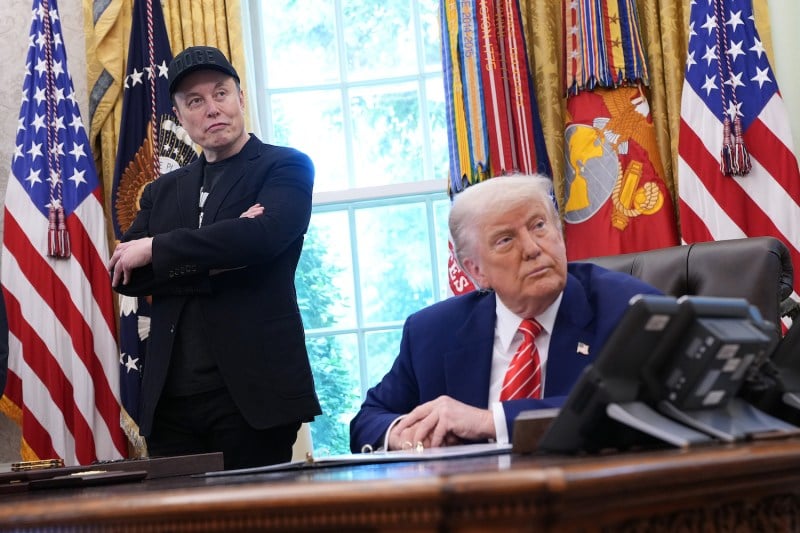Is the U.S.-Ukraine Rare-Earth Deal All Talk?

Is the U.S.-Ukraine Rare-Earth Deal All Talk?
Kyiv may have the critical minerals, but that’s just one part of the equation.
U.S. President Donald Trump and Ukrainian President Volodymyr Zelensky shake hands during a meeting in New York on Sept. 25, 2019. Saul Loeb/AFP via Getty Images
Washington and Kyiv appear to be inching closer to a potential rare-earth deal that could see the countries exchange Ukraine’s mineral resources for continued U.S. aid, even as industry experts warn that immense barriers stand in the way.
Rare earths—a set of 17 metallic elements that are not actually that rare, despite their name—are important to U.S. policymakers because they underpin technology from guided missiles to wind turbines. But China overwhelmingly commands their global supply chains, making control of the resources a strategic vulnerability that Washington has for years been desperate to plug.
Washington and Kyiv appear to be inching closer to a potential rare-earth deal that could see the countries exchange Ukraine’s mineral resources for continued U.S. aid, even as industry experts warn that immense barriers stand in the way.
Rare earths—a set of 17 metallic elements that are not actually that rare, despite their name—are important to U.S. policymakers because they underpin technology from guided missiles to wind turbines. But China overwhelmingly commands their global supply chains, making control of the resources a strategic vulnerability that Washington has for years been desperate to plug.
Both Ukrainian President Volodymyr Zelensky and U.S. President Donald Trump have seemed excited about the prospect of a deal, with the U.S. leader declaring that he wants “the equivalent of, like, $500 billion worth of rare earths.” Talks appeared to advance on Wednesday as U.S. Treasury Secretary Scott Bessent met with Zelensky in Kyiv—making him the first official in Trump’s cabinet to travel to the country.
Afterward, Bessent said a minerals agreement was part of a “larger peace deal that Trump has in mind” and would “provide a long-term security shield” for Ukraine. Zelensky said the Trump administration had presented a first draft agreement, which Kyiv would assess, and that he hoped to finalize a deal at the upcoming Munich Security Conference.
Even if Kyiv and Washington do strike a deal, big challenges lie ahead.
While Ukraine is home to considerable rare earths and minerals such as uranium and titanium, it does not currently produce rare earths, nor has it produced rare earths in recent decades, according to the U.S. Geological Survey. Geological data and information is scant, per Reuters, and We Build Ukraine, a Kyiv-based think tank, estimates that Russia’s occupation has rendered 40 percent of Ukraine’s metallic mineral riches inaccessible. Zelensky has said under 20 percent of the country’s mineral resources are under Russian occupation.
“Trump may have better relations with Russia, but you can’t develop a mine from scratch and extract resources in three or four years,” said Gracelin Baskaran, a critical minerals security expert at the Center for Strategic and International Studies, who noted that on average globally, it takes 15 years to develop a mine. “It’s a decades-long undertaking.”
And getting the resources out of the ground is just one part of the problem. Engineering new mineral supply chains requires an entire ecosystem of processing, refining, and manufacturing systems, all of which take time and investment to build. With the Russia-Ukraine war, there is not a lot of private sector appetite to work in Ukraine, Baskaran said.
“I think it’s a smart move from Zelensky as a way to convince the new administration,” said Bryan Bille, a policy expert at Benchmark Mineral Intelligence. “But in the end, it’s a question about developing these deposits, bringing these projects online, which could take years.”
Christina Lu is an energy and environment reporter at Foreign Policy. X: @christinafei
More from Foreign Policy
-

Russian President Vladimir Putin looks on during a press conference after meeting with French President in Moscow, on February 7, 2022. The Domino Theory Is Coming for Putin
A series of setbacks for Russia is only gaining momentum.
-

The container ship Gunde Maersk sits docked at the Port of Oakland on June 24, 2024 in Oakland, California. How Denmark Can Hit Back Against Trump on Greenland
The White House is threatening a close ally with a trade war or worse—but Copenhagen has leverage that could inflict instant pain on the U.S. economy.
-

Donald Trump speaks during an event commemorating the 400th Anniversary of the First Representative Legislative Assembly in Jamestown, Virginia on July 30, 2019. This Could Be ‘Peak Trump’
His return to power has been impressive—but the hard work is about to begin.
-

US Secretary of State Marco Rubio greets employees at the State Department in Washington, DC, on January 21, 2025. The National Security Establishment Needs Working-Class Americans
President Trump has an opportunity to unleash underutilized talent in tackling dangers at home and abroad.









Join the Conversation
Commenting on this and other recent articles is just one benefit of a Foreign Policy subscription.
Already a subscriber?
.
Subscribe
Subscribe
View Comments
Join the Conversation
Join the conversation on this and other recent Foreign Policy articles when you subscribe now.
Subscribe
Subscribe
Not your account?
View Comments
Join the Conversation
Please follow our comment guidelines, stay on topic, and be civil, courteous, and respectful of others’ beliefs.
Change your username |
Log out
Change your username:
CANCEL
Confirm your username to get started.
The default username below has been generated using the first name and last initial on your FP subscriber account. Usernames may be updated at any time and must not contain inappropriate or offensive language.